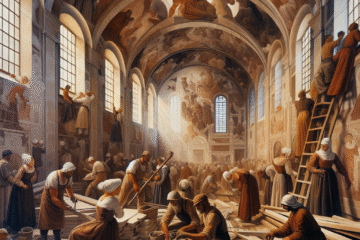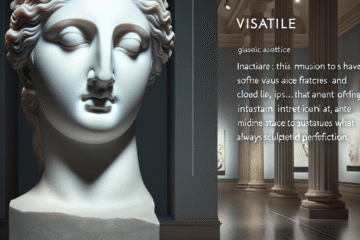I. Introduction
Abstract painting is a unique form of visual art that does not attempt to represent the natural world realistically. Instead, it focuses on the use of color, shape, form, and texture to create compositions that express emotions, ideas, or concepts. While abstract painting can be traced back to ancient cultures like the Aboriginal art of Australia, it became a significant movement in the 20th century.
The birth of abstract painting as an art form can be traced to the early 1900s, when artists began to reject traditional artistic conventions and sought new ways to express themselves. One of the key pioneers of abstract art was Wassily Kandinsky, a Russian painter and art theorist. In his 1910 manifesto, “Concerning the Spiritual in Art,” Kandinsky argued that art should not merely reproduce the visible world but should instead be a tool for communicating emotions and ideas. He believed that abstract art had the power to evoke feelings and ideas in viewers that could not be expressed through representational art.
Other artists soon followed Kandinsky’s lead, including the Dutch painter Piet Mondrian and the French painter Georges Braque. Mondrian believed that art should reflect the spiritual dimension of life and that abstract forms and colors could help to achieve this. Braque, who co-founded the Cubist movement with Pablo Picasso, began experimenting with abstract forms in his paintings as early as 1911.
Abstract painting gained even more popularity in the 1940s and 1950s with the emergence of Abstract Expressionism, a movement that emphasized the act of painting itself as a form of expression. Artists like Jackson Pollock and Willem de Kooning used bold, gestural brushstrokes and drips to create large-scale canvases that embodied the energy and spontaneity of their creative process.
Today, abstract painting continues to be a vital and dynamic form of art, with countless artists working in a variety of styles and mediums. From the vibrant, colorful canvases of Mark Rothko to the textural, organic sculptures of Anish Kapoor, abstract art offers a wide range of visual experiences and interpretations for viewers to explore. Whether you’re drawn to the bold, graphic forms of minimalism or the emotive, expressionistic brushwork of gestural abstraction, there’s an abstract painting out there that’s sure to capture your imagination.
II. Elements of Abstract Painting
Abstract painting is an art form that allows artists to experiment with a variety of elements and principles to create unique and expressive compositions. These elements include form, color, texture, line, and composition. In this article, we will explore each of these elements in detail and showcase examples of famous abstract paintings that demonstrate their use.
Form: Form in abstract painting refers to the overall shape and structure of the composition. Abstract artists often use non-representational shapes and forms to create a sense of movement and visual interest. Shapes can be geometric or organic, and they can be arranged in a variety of ways to create a sense of balance or tension. For example, in Wassily Kandinsky’s Composition VIII, the artist uses circular and triangular shapes to create a dynamic, interconnected composition that draws the viewer’s eye around the canvas.
Color: Color is perhaps the most important element of abstract painting. Artists use color to create mood, evoke emotion, and express ideas or concepts. In abstract art, color is often used in a bold and expressive way, with bright hues and contrasting tones used to create visual impact. Some abstract painters work with a limited palette, while others use a wide range of colors to create a vibrant and energetic composition. One famous example of the use of color in abstract painting is Mark Rothko’s No. 61 (Rust and Blue), which features two large, rectangular forms in warm rust and cool blue hues.
Texture: Texture in abstract painting refers to the physical quality of the painting’s surface. Artists can create texture by applying paint thickly or thinly, using a variety of tools and techniques to create different effects. Texture can add depth and dimension to a painting, creating a tactile quality that invites the viewer to engage with the work. In Jackson Pollock’s famous drip paintings, texture is created by the artist’s use of a drip technique that creates a layered, textured surface.
Line: Line in abstract painting can refer to a variety of marks, from thin, delicate lines to bold, expressive strokes. Lines can be used to create movement, define shapes, or draw attention to certain areas of the composition. In the work of artists like Joan Mitchell and Cy Twombly, lines are used in an expressive, gestural way, creating a sense of energy and motion in the composition.
Composition: Composition in abstract painting refers to the arrangement of elements within the painting. Artists use composition to create a sense of balance, movement, or tension within the work. Some abstract painters use a symmetrical composition to create a sense of harmony, while others use a more asymmetrical approach to create visual interest and tension. One famous example of composition in abstract painting is Piet Mondrian’s Composition II in Red, Blue, and Yellow, which features a grid of primary-colored rectangles that create a sense of balance and order within the painting.
In conclusion, the elements of abstract painting offer artists a rich and varied toolkit for creating unique and expressive works of art. By experimenting with form, color, texture, line, and composition, abstract painters can create compositions that evoke emotions, express ideas, and engage the viewer in a dynamic visual experience. Whether you prefer the bold, expressive brushstrokes of Abstract Expressionism or the minimalist forms of geometric abstraction, there is a world of abstract painting waiting to be explored.
III. Techniques for Creating Abstract Paintings
Abstract painting is an art form that allows artists to explore a wide range of techniques and materials to create unique and expressive works of art. While there is no single “correct” way to create an abstract painting, there are some common techniques that many artists use to achieve their desired effects. In this article, we will explore some of these techniques and provide step-by-step instructions for creating an abstract painting using one of them.
Layering: Layering is a technique that involves building up multiple layers of paint on the canvas to create depth and texture. To create a layered abstract painting, start by applying a thin layer of paint in a color of your choice to the canvas. Once this layer is dry, apply another layer of paint in a contrasting color on top. Continue adding layers in this way, using a variety of colors and brushstrokes to create a rich and textured surface.
Dripping: Dripping is a technique that involves allowing paint to drip or flow down the canvas in a controlled or random way. To create a dripping abstract painting, start by selecting a few colors of paint and thinning them with water or a medium. Then, hold the canvas at an angle and drip the paint onto the canvas, allowing it to flow down the surface. Use a brush or other tool to guide the paint in the direction you want it to go. Experiment with different colors and techniques to create a dynamic and visually interesting composition.
Scraping: Scraping is a technique that involves using a tool like a palette knife to scrape away layers of paint to reveal the layers underneath. To create a scraped abstract painting, start by layering different colors of paint on the canvas as described above. Once the paint is dry, use a palette knife or other tool to scrape away some of the paint to reveal the layers underneath. This can create a sense of depth and texture, as well as reveal unexpected colors and patterns.
Splattering: Splattering is a technique that involves flicking or splattering paint onto the canvas to create a random and expressive pattern. To create a splattered abstract painting, start by selecting a few colors of paint and thinning them with water or a medium. Then, use a brush or other tool to flick the paint onto the canvas, creating a random and spontaneous pattern. Experiment with different colors and techniques to create a dynamic and visually interesting composition.
Step-by-Step Instructions: Here are step-by-step instructions for creating an abstract painting using the layering technique:
Materials:
- Canvas
- Acrylic paint in a variety of colors
- Paint brushes
- Water or medium for thinning the paint
Instructions:
- Start by selecting a few colors of paint that you want to use in your painting.
- Apply a thin layer of paint to the canvas using a paint brush.
- Once the paint is dry, apply another layer of paint in a contrasting color on top.
- Continue layering different colors of paint, allowing each layer to dry before adding the next.
- Experiment with different brushstrokes and techniques to create a rich and textured surface.
- Step back and evaluate the painting as you work, adding or subtracting layers as needed to achieve your desired effect.
- Once you are happy with the painting, allow it to dry completely before displaying it.
In conclusion, abstract painting is a versatile and exciting art form that allows artists to explore a wide range of techniques and materials to create unique and expressive works of art. By experimenting with layering, dripping, scraping, splattering, and other techniques, artists can create compositions that evoke emotion, express ideas, and engage the viewer in a dynamic visual experience. So, grab your canvas and paintbrushes and let your imagination run wild!
IV. Styles of Abstract Painting
Abstract painting is a diverse and complex art form that encompasses a wide range of styles and techniques. Over the course of the 20th century, a number of distinct styles of abstract painting emerged, each with its own unique characteristics and artists associated with it. In this article, we will explore some of the major styles of abstract painting and provide examples of famous artists associated with each style.
Geometric Abstraction: Geometric abstraction is a style of abstract painting that uses simple geometric forms like squares, circles, and rectangles to create a sense of order and balance. The artists associated with this style sought to create compositions that were objective and rational, free from the emotional content of other abstract styles. Famous artists associated with geometric abstraction include Piet Mondrian, Kazimir Malevich, and Theo van Doesburg.
Expressionism: Expressionism is a style of abstract painting that emphasizes the emotional and psychological aspects of the creative process. Artists associated with this style often used bold, gestural brushstrokes and vivid colors to create compositions that expressed their innermost feelings and emotions. Famous artists associated with expressionism include Jackson Pollock, Willem de Kooning, and Mark Rothko.
Surrealism: Surrealism is a style of abstract painting that emphasizes the subconscious and the irrational. Artists associated with this style often used dreamlike imagery and unexpected juxtapositions to create compositions that challenged the viewer’s perception of reality. Famous artists associated with surrealism include Joan Miró, Max Ernst, and René Magritte.
Color Field Painting: Color field painting is a style of abstract painting that focuses on large fields of color and simple, unstructured compositions. The artists associated with this style sought to create works that were contemplative and meditative, using color to create a sense of depth and emotion. Famous artists associated with color field painting include Mark Rothko, Barnett Newman, and Helen Frankenthaler.
Cubism: Cubism is a style of abstract painting that emphasizes the use of geometric forms and multiple viewpoints to create a sense of dimensionality and depth. The artists associated with this style sought to represent objects and scenes from multiple perspectives at once, creating complex and layered compositions. Famous artists associated with cubism include Pablo Picasso and Georges Braque.
In conclusion, abstract painting is a rich and diverse art form that encompasses a wide range of styles and techniques. Whether you are drawn to the order and simplicity of geometric abstraction, the emotional expressiveness of expressionism, or the surreal dreamscapes of surrealism, there is an abstract style out there that is sure to capture your imagination. So, take some time to explore the different styles of abstract painting and discover the artists and works that speak to you.
V. The Meaning and Interpretation of Abstract Art
Abstract art is an art form that often prompts questions from viewers, such as “what does it mean?” or “what is it supposed to represent?” However, unlike representational art, which portrays recognizable objects or scenes, abstract art often does not have an immediately identifiable subject matter. This leaves the interpretation of the work up to the viewer, based on their own experiences and perspectives. In this article, we will explore how abstract art can convey emotion, symbolism, and ideas without representing recognizable objects and discuss the different ways viewers can interpret abstract art.
Emotion: One of the primary ways that abstract art conveys meaning is through the use of emotion. Abstract artists often use color, line, and texture to create a sense of mood or feeling within the composition. For example, the use of bold, vibrant colors can create a sense of energy and excitement, while muted tones can create a sense of calm or introspection. Similarly, the use of jagged, angular lines can create a sense of tension or anxiety, while smooth, flowing lines can create a sense of tranquility or harmony. Ultimately, the emotional impact of an abstract artwork is up to the interpretation of the viewer, and different viewers may experience different emotions or reactions when looking at the same work.
Symbolism: Another way that abstract art can convey meaning is through the use of symbolism. While abstract art may not represent recognizable objects or scenes, it can still contain symbols or visual elements that carry meaning. For example, an artist may use a particular color to represent a specific emotion or idea, or use a particular shape to represent a concept or theme. The meaning of these symbols may not be immediately apparent, but can be uncovered through careful analysis and interpretation.
Ideas: Finally, abstract art can convey meaning through the exploration of ideas and concepts. Many abstract artists seek to express complex ideas or philosophies through their work, using abstract forms and colors to communicate their message. For example, an artist may use the repetition of shapes or patterns to convey a sense of order or chaos, or use the interplay of light and shadow to explore themes of duality or contrast. The meaning of these ideas may be open to interpretation, but can lead to thought-provoking and meaningful discussions about the nature of the world and the human experience.
Interpretation: The interpretation of abstract art is ultimately up to the viewer, and can be influenced by a variety of factors, including personal experiences, cultural background, and emotional state. Two viewers may look at the same abstract artwork and come away with completely different interpretations based on their own unique perspectives. However, this is part of what makes abstract art so powerful and enduring – its ability to connect with viewers on a deeply personal and emotional level, regardless of their individual interpretations.
In conclusion, abstract art may not have an immediately identifiable subject matter, but it can still convey meaning through the use of emotion, symbolism, and ideas. The interpretation of abstract art is ultimately up to the viewer, and can lead to thought-provoking and meaningful discussions about the nature of art and the human experience. So, take some time to explore the world of abstract art and discover the meanings and interpretations that resonate with you.
VI. Conclusion
In this article, we have explored the world of abstract painting, including the elements of abstract painting, techniques for creating abstract paintings, styles of abstract painting, and the meaning and interpretation of abstract art. We have learned that abstract art is a diverse and complex art form that allows artists to explore a wide range of techniques and materials to create unique and expressive works of art. We have also discussed how abstract art can convey emotion, symbolism, and ideas without representing recognizable objects, and how the interpretation of abstract art is ultimately up to the viewer.
Despite its abstract nature, abstract art continues to be a popular and influential form of expression. It allows artists to push the boundaries of traditional representational art and explore the possibilities of color, form, and texture. Abstract art can also evoke deep emotional responses from viewers, prompting them to reflect on their own experiences and perspectives. Additionally, abstract art has played a significant role in the history of modern art, influencing movements such as Cubism, Surrealism, and Expressionism.
In conclusion, the world of abstract painting is vast and varied, offering endless possibilities for exploration and expression. Whether you prefer the order and simplicity of geometric abstraction or the emotional expressiveness of expressionism, there is an abstract style out there that is sure to capture your imagination. So, take some time to explore the key elements and techniques of abstract painting, and discover the styles and artists that resonate with you. Who knows – you may just discover a new favorite work of art that speaks to you on a deep and meaningful level.


